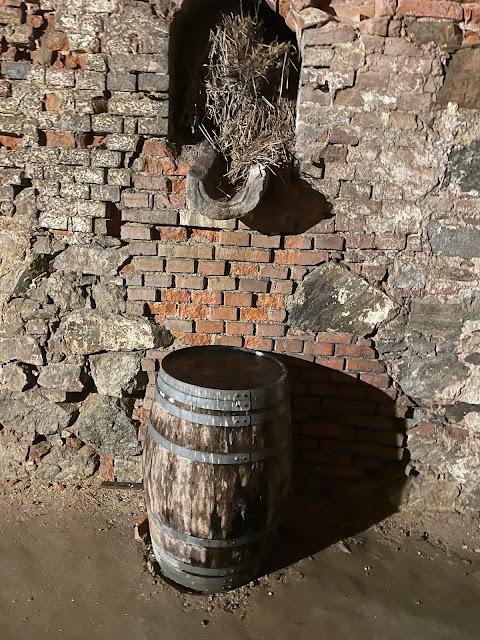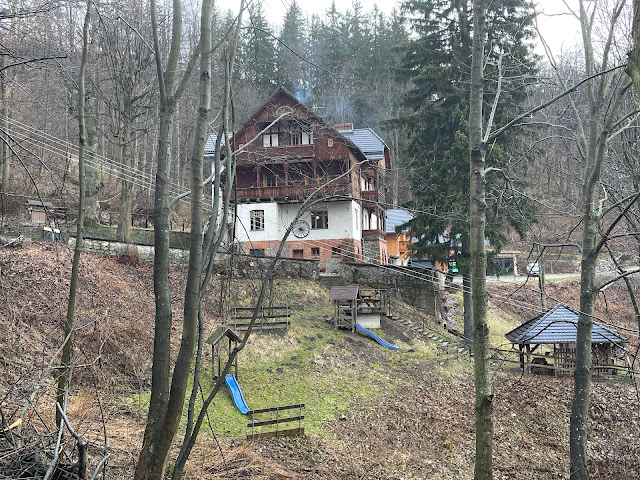The main ones we missed were Chojnik Castle and Castle Czocha. We did make it Książ Castle and Srebrna Gora.
Our first drive was out to Książ Castle (Zamek Książ). Książ is the largest castle in Silesia and the third largest in Poland.
The first castle was built in 1288-1292 by a Silesian Duke, Bolko I the Strict. The castle then passed on to King Wenceslaus IV of Bohemia. It was subsequently sold and ended up being renamed Schloss Fürstenstein. This castle was destroyed in 1482 in a war against the Hungarians, who took over the area and rebuilt the castle in the 16th century in Renaissance style.
The castle was captured by the Nazis in 1944 and then the communists after the war.
Książ castle has over 400 rooms and takes up 11,000 square meters, it also sits in the Książ Landscape Park.
We didn't end up going inside the castle, but we walked around the outside and visited a nearby lookout to get a view of the whole castle:
 |
| The entrance yard - looking away from the castle |
On the way to the castle I had been randomly clicking on google maps points on interest nearby and found an interesting statue and church in the nearby town of Świdnica. We took a quick drive through the area, we didn't have time to find the church but we found the statue. The kids weren't super keen to get out the car when they realized the statue was outside the sewerage treatment plant, but it was a fitting place for the statue of Srający chłopek (Pooping man):
After this short detour we arrived at Fort Srebrna Góra (Silver Mountain Fort).
The original fortress was built in 1764-1777 by Frederick II, King of Prussia to defend the nearby passes. It consists of six forts, the main one being Donżon Fort, which we visited.
The fortress was built after the Seven Year's War (1760) between Prussia and Austria. After the peace treaty was signed, the area was reclaimed by the Prussians, the fortress was ordered built to protect the passage from Silesia to Klodzko County.
The fort was never captured during wartime, and in 1807 it successfully defended a siege by Napoleon's forces - the only time the fortress was actively under attack. In 1860 it was no longer needed as a fort and it was abandoned in 1867. For a while it served as a military training ground and then became a tourist attraction in the late 1800s.
During World War II it served as a Prisoner-Of-War camp (Oflag VII-B and Stalag 367).
The fort is a star fort formation, made of four main towers, The Eagle Gate at the front, flanked by Town Tower on the left and Lower Tower on the right. The left-most rear tower is New Village Tower and the rightmost is Upper Tower.
The towers and casements were armed with cannons that had a 2km range allowing them to cover the roads below from several angles.
Cars were not allowed to drive all the way up to the fort (except for disabled passholders), so we found a carpark at the bottom. Once we parked we were approached by a lady with an official name badge and payment terminal for the 15 zloty parking fee (about $5). We paid and when she returned to her 'base' we were a little worried we'd been scammed. She had a battered van with plastic covered windows that was up on bricks in the carpark. The insides were littered with cigarette butts and bottles. It did turn out that it was a legitimate parking fee, but the kids were worried we'd come back to the car missing.
It was a bit of a hike up to the fort, on switchback roads, but the fort itself was impressive. The tower looks amazing from an above view - one we couldn't capture due to being firmly attached the ground, but we did get a picture of a poster inside and this site has some great pictures.
 |
| View from above |
We paid for an audio tour and set out to the castle.
On the way up, Kris was quite taken by this little hotel, but particular the fence that was installed at the end of the slide to, in her words "stop the kids from rolling all the way to the bottom of the hill":
Later in the tour there was an impressive model of the fort, I'll show it now to give a better idea of the layout as we progressed:
The gate the boys are standing at is the one in the bottom right, leading to the sunken area above. This then leads to the drawbridge (now replaced with an earthen bridge) to Donjon - the gate show in the middle of the picture.
Once inside there was a central courtyard surrounded by the casements and towers.
The Donjon marking and crest below it are original. The crest was originally an eagle with FR for Frederikus Rex (King Frederick).
Passing through the gate we came to the main courtyard:
 |
| Sign showing how the gate once looked |
 |
| Looking out of the courtyard to the tunnel leading back out to Donjon |
The first exhibit was of postcards showing the area - some from the 1800s when the site first became a tourist attraction. There was also a selection of broken crockery, glassware and bottles from a restaurant that had existed on the site in the early 1900s.
The next display was for the artillery used, including the cannons and mortars. The audioguide explained how the cannons could be loaded and the purpose of the different cannonballs.
 |
| Cannon tools - the top two are used to clean the barrel and the lower holds the flame to light the fuse |
 |
| Ammunition including grape shot and cannon balls. The cloth wrapped items are grapeshot, wadding and a gunpowder charge - similar to a modern bullet. |
 |
| Cannonballs and grenades |
The next section was uniforms, weapons and personal effects found on the site:
 |
| From left to right - Prussian Infantryman, Naval uniform, Artillery Uniform |
 |
| Austrian Uniform and a pile of grenades |
 |
| Collection of coins, buckles and buttons |
 |
| Badge of the Black Eagle of Prussia |
 |
| Coins |
 |
| Weapons and ammunition |
Moving on from the armoury we visited a bedroom. The fort did not have distinct kitchen areas, so there were small 'black kitchens' in nooks and in some of the central rooms. In times of peace, the soldiers would generally live in the towns, but in times of war they would sleep in dormitories within the casements. These were often very cold (or hot depending on the weather) and condensation and ground water was a constant problem:
Also displayed was the "Spanish Donkey." The person to be punished was sat astride the donkey and had cannonballs tied to each of their feet. This added weight would pull them down on the sharply angled wood, causing severe pain:
 |
| A drain to capture water penetrating the walls - to both prevent flooding and to provide drinking water |
By the time we finished up at the fort it was starting to get late, so we headed back to the car and drove to our next town, Katowice. We weren't going to have much time to check out the city, but we had plans to visit a big castle ruin the next day on the way to Krakow.
Our apartment this time was the worryingly named "Good Times House", which was a hostel in the middle of the city. We picked it because it was cheap, had private rooms and private parking. Finding it in the dark was a pain. Googlemaps showed it in the middle of a block of buildings, accessibly only by alleys that were filled with sex shops, medicinal marijuana stores and suss-looking people. After a fair bit of arguing and driving around we finally found the entrance.
Our apartment was the Flipper room and was themed around old pinball machines. Kris had picked up a migraine at this point, so went to bed and I took the boys for a walk to get dinner. Then it was an early night ready for the early start the next day.
 |
| This guy looked like he enjoyed pinball a little too much! |
























































No comments:
Post a Comment